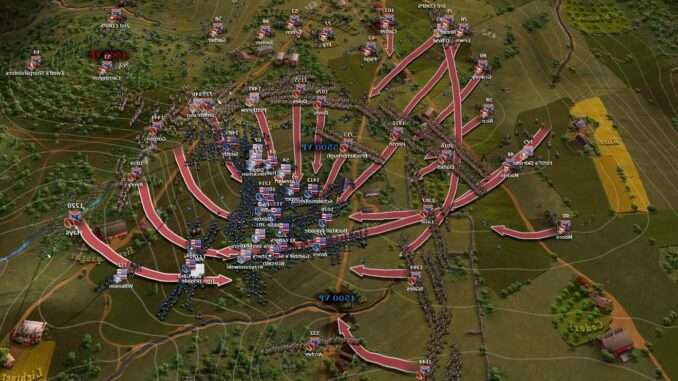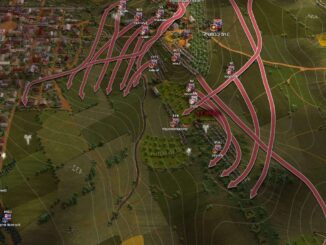
Table of Contents
A Short History
Note: Credit goes to Panzergrenadier
Skirmishers are light infantry or light cavalry soldiers deployed as a vanguard, flank guard, or rearguard to screen a tactical position or a larger body of friendly troops from enemy advances. They are usually deployed in a skirmish line – an irregular open formation much more spread out in depth and breadth than a traditional line formation. Their purpose is to:
- Hharass the enemy.
- Engaging them in only light or sporadic combat in order to delay their movement.
- Disrupt their attack and or weaken their morale.
These tactics are collectively called skirmishing.
A battle with only light, relatively indecisive combat is often called a skirmish, even if heavier troops were sometimes involved.
Skirmishers can be either regular army units temporarily detached to perform skirmishing, or specialty units specifically armed and trained for such low-level irregular warfare tactics. Light infantry, light cavalry, and irregular units often specialize in skirmishing. Skirmishers’ open formations and smaller numbers can give them superior mobility over the regular forces, allowing them to only engage on favorable terms, taking advantage of better position or terrain and quickly withdrawing from any threat of superior enemy forces.
Though often critical in protecting the main army from sudden enemy advances, skirmishers are poor at taking or defending ground from heavy infantry or heavy cavalry. In modern times, following the obsolescence of such heavy troops, all infantry has become indistinguishable from skirmishers, and the term has effectively lost its original military meaning as a distinct class of soldier, although skirmishing as a combat role is commonplace.
During the American Civil War, it was common for cavalrymen to dismount and form a skirmish line to delay enemy troops advancing towards an objective. For example, the actions of the Union cavalrymen led by Brigadier General John Buford on the first day of the Battle of Gettysburg.
Skirmish lines were also used to harass enemy probing missions, hampering the other force from gaining an effective intelligence picture by engaging their scouts and likewise forcing them to deploy.
Skirmishers were meant to ‘feel’ towards the enemy as the two armies advanced towards one another. This is a distinct mission from that of cavalry which was intended find the enemy.
Infantry skirmish line is advancing towards the enemy that is already known to be in its front and quite often is supposed to bring on the battle.
Conversely, an army of the defensive would send out skirmishers to act as an early warning sign in case of an enemy attack. For example, at Little Round Top where Company B, 20th Maine was deployed behind a stone wall to:
- Find the enemy
- Engage the enemy
- Determine his intentions
- And, if possible, thwart the enemy
European armies of the 18th and 19th Centuries often used special infantryman specifically trained for skirmishing by organizing special regiments of sharpshooters. Early in the American Civil War, US and CS armies try to emulate this by organizing special regiments of sharpshooters. The two most famous US sharpshooter regiments were those commanded by Colonel Hiram Berdan. These were men who were recruited across the North for their marksmanship. They had to pass a special test before being allowed to join the sharpshooters. Once, enlisted into the ranks, they were issued a distinctive green cap and green coat and a special target rifle.
The green uniform gave the sharpshooters the clear advantage of camouflage, but also sometimes was a disadvantage because they were easy to distinguish against the rest of the Union soldiers for Confederate marksmen to spot and target. US Sharpshooters were high-priority kills amongst the Confederate army, because they had such high skills and good salvageable equipment.
The men of the US Sharpshooters regiment were armed with various types of rifles, including the Sharps rifle, the Whitworth rifle, sporting arms, and various other custom-made privately owned target weapons. Some of these rifles weighed up to 30 pounds (14 kg) because they contained the first breed of telescope sights. At first, many of the Sharpshooter riflemen used their own weapons, but this began leading to problems when it came to ammunition supply. As a result, Berdan made a request to receive issuance of Sharps rifles to his men.
Confederates also had sharpshooter battalions, though, often without a green uniform.
The word sharpshooter presents a bit of a problem. It seems, men from both North and South used the term liberally to describe any man who had to be an excellent shot. So, while organized sharpshooter regiments, battalions or companies were often operating in front of the front lines performing the roles of modern-day snipers, it would be incorrect to assume any man who was felled by a well-placed shot was shot by an actual sharpshooter.
Sharpshooters were excellent skirmishers, but some skirmishers were excellent sharpshooters. It’s worth noting, that a skirmish company from the 20th Maine at Gettysburg fought side by side with men from the 2nd US Sharpshooters, but all troops performed the same role whether they were blue or green. The vast majority of skirmishing was done by the average infantry soldier of both armies – detached skirmishers. In fact, this is one of the many things that soldiers practiced on the drill field. When advancing towards the enemy, the attacking force would deploy its skirmishers. It could be a company or a regiment or an entire brigade. These are men who advanced in front of the main battle line as much as five paces apart, regardless, of the size of the skirmish detachment. The most important unit is called the ‘comrade of arms.’ These are four soldiers who are working closely with one another. Two pairs watching their fire to make sure there is always one or two loaded muskets pointed towards the enemy. So, while one man is firing, the other is reloading his musket, so, there is a constant rate of fire being kept on the enemy as they advanced. This is the same tactic used on the defensive when units are retreating. The idea is to sweep away early enemy resistance in front of an attack or to keep an attack at bay while the defenses are being prepared. Once, the main force is ready to attack or the defender are ready to receive an attack, the skirmishers will reform into a standard battle line and withdraw and await further orders. For example, Lookout Mountain, November 1863, when the skirmish line in front of Geary’s Division after engaging the enemy, reforms and, then, later makes a charge of their own during the fighting on Lookout Mountain. Most charges of the Civil War were preceded by a long thin line of men working closely with one another to bring on those pivotal moments in our nation’s history.
How to Use Skirmishers
Skirmishers are soldiers who fight in loose formation and automatically try to keep distance from the enemy. Skirmishers are benefited from their large cover bonus and stealth. They can be used to hide inside forest and ambush, harass enemy flanks, delay the advance of enemy and scout behind enemy lines. Skirmishers are not useful for holding a defensive position because they are very vulnerable to melee attacks.
Skirmisher units are small, 300 – 850 men, equipped with special weapons, special light infantry. Skirmishers are highly mobile, able to cover ground swiftly and use an open formation while keeping heavier enemy infantry formations off balance, only engaging when the conditions are favorable.
Skirmisher tactics is one of rapid movement, flank harassment and confusing the enemy with continuous maneuvering to compensate for their inferiority in strength and firepower. Skirmisher units require a high degree of micromanagement. Best used to probe, reconnaissance, counter reconnaissance, locate, screen, delay, defense, flank, get behind or stop enemy units. Note: I did not say, attack.
Never use skirmishers to attack, charge or melee. Artillery has the longest Line of Sight. Skirmishers has the second longest LoS. Skirmishers are used for close in security and fight. Cavalry has the third longest LoS. Cavalry is used for the distant security of an army. Skirmishers have a longer firing range than infantry brigades because by default they are armed with special target rifles.
They are more accurate with a faster reload, than regular infantry. Therefore, expect higher casualties and lowing morale. Skirmishers run away after shooting to reload their rifles. Cavalry, skirmishers and generals RUN by default, but will fatigue more quickly. Watch their CONDITION. Artillery cannot run.
It is best to use skirmishers to turn an enemy flank or better yet, get behind an enemy unit, “hammer and anvil tactic,” because of their default RUN speed.
This is a simple tactic. The hammer and anvil tactic work by using two forces, one stationary, “the anvil,” and one mobile, “the hammer.” The stationary force “fixes” the adversary and prevents escape while the mobile force moves toward it with the adversary caught between.
The best anvil is a three-star brigade. Avoid losses, as much as possible, especially of a low numbers of men skirmisher unit. Never let your skirmisher strength go below 150 men. Do not underestimate the kills a flanking skirmisher unit can do to an elite enemy brigade. Use skirmishers and artillery to prevent the enemy from regaining morale and condition.
The Best Defense Against Enemy Skirmishers
The greatest danger to skirmishers is from cavalry. Do not let your skirmisher get caught in the open against charging cavalry. If attacked in the open your skirmishers, should retreat back to their infantry and artillery supports who should be prepared to receive cavalry.




Be the first to comment